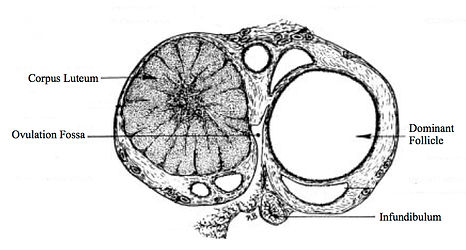Physiology of the Non-Pregnant Mare's reproductive System
The mare is a seasonal polyestrian meaning that she has several successive estrus during a period of the year and she has a period of sexual rest without estrus during the other part of the year. In Quebec, in the northern hemisphere, the mare's breeding season generally extends from March-April to August-September.
The estrous cycle
The duration of the estrous cycle can be defined as the interval between two consecutive ovulations. The estrous cycle can also be defined as the process of ovulation, ie the follicular phase or estrus, and the interovulation period, ie the luteal phase or diestrus.
During estrus, the mare is in heat and is sexually receptive to the stallion. Follicles develop and secrete hormones (estrogen). It is at the end of this phase that a dominant follicle will ovulate (thus becoming a corpus luteum producing progesterone).

During the diestrus, the mare is no longer receptive to the stallion. During this phase, there are two possibilities:
-
Following fertilization, the reproductive system prepares for pregnancy.
-
In the absence of fertilization, the corpus luteum regresses and a new cycle begins.
The average duration of an estrous cycle in the mare is 21-22 days (ranging from 18 to 24 days). Estrus lasts between 4 and 7 days and diestrus is usually constant at 14-15 days. The duration of estrus can also be more variable depending on the season, being typically longer at the beginning of the breeding season.

Many hormones secreted by the brain, ovaries and endometrium are involved in the physiology of the reproductive system in mares. These hormones (melatonin, GnRH, FSH, LH) self-regulate with each other to control the regular pattern of the estrous cycle.
Follicular phase:
During this phase, several follicles will mature and grow in the ovaries. One follicle will stand out and become the dominant follicle. It is the dominant follicle that will grow the most and eventually ovulate. In general, the diameter of a follicle at ovulation is 30 to 50mm. Ovulation is spontaneous and occurs 24 to 48 hours before the end of estrus. During the follicular phase, estrogen is secreted. It is this hormone that produces signs of heat in the mare: agitated, swollen vulva, vulva winking, small frequent urination, tail raising, etc.
The luteal phase:
This phase begins following ovulation and the formation of a corpus luteum producing progesterone. It is progesterone that stops the mare's signs of sexual receptivity. The lifespan of the corpus luteum is dependent on the secretion of prostaglandin or not by the endometrium of the uterus. After 13 to 16 days post-ovulation, if the endometrium recognizes the presence of a pregnancy, there will not be release of prostaglandin to preserve the corpus luteum and the secretion of progesterone, which is essential to the maintenance of gestation. If no pregnancy is detected, there will be secretion of prostaglandins, destruction of the corpus luteum and decline of circulating progesterone to start a new cycle.

Transition periods
As a seasonal polyoestrian, the mare goes through periods of transition between her periods of sexual receptivity and sexual rest. In fact, the physiology of the mare's reproductive system can be divided into 4 seasons corresponding to variations in day length.
-
Peak of fertility, ie breeding season: longest days of the year, centered on the summer solstice (21-22 June).
-
Transition period, ie erratic oestral behavior without ovulation: period when days and nights are of equal duration, centered on the autumnal equinox (21-22 September).
-
Anestrus, ie sexual rest: shortest days of the year, centered on the winter solstice (21-22 December).
-
Transition period, ie long and erratic oestral behavior culminating in ovulation: period when days are getting longer, centered on the spring equinox (March 21-22).
About 15 to 20% of mares do not follow this cyclicity and continue to cycle regularly throughout the year. In addition, within a mare, the seasonal pattern of reproductive activity can vary considerably from year to year.

